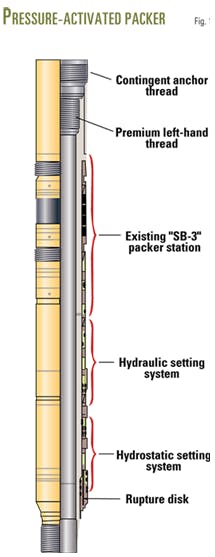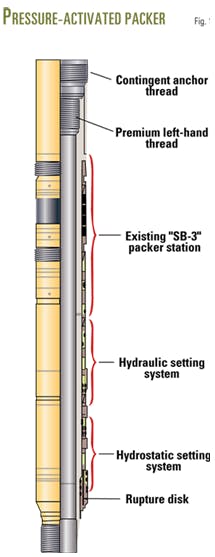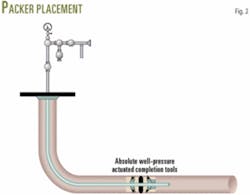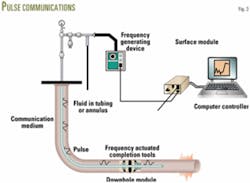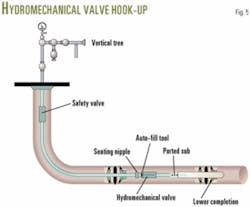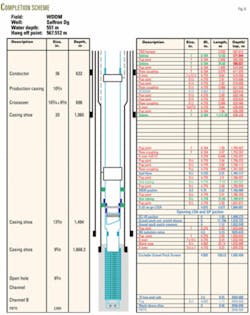Operators can reduce costs and risks involved in completing wells by using pressure-pulse communication, absolute well pressure, or a hydromechanical valve to set wellbore packers.
In deepwater, horizontal, and extended-reach applications, these interventionless actuation systems for setting completion tools reduce well intervention and completion time and associated costs without compromising reliability or safety.
An examples well completion illustrates the selection process for determining the correct interventionless technology for a given application.
Well completions
The offshore oil and gas industry's current focus is on the prolific but challenging area of deepwater, where water depths exceed 1,000 ft. This is the industry's largest growth segment, and technologies that provide operational reliability, flexibility, and cost effectiveness have made this growth possible.
Conventional completion practices require setting downhole packers to isolate and control pressure and fluids from a producing zone. To enhance efficiency, the preferred packer setting method is a one-trip hydraulic system.
In these systems, a single trip runs the packer on the production string, followed by running of a blanking plug into a seating nipple below the packer. The plug is then removed after the packer is set by hydraulic pressure in the tubing. This intervention can take from 12 hr to 2 days of rig time and introduces such risks as losing wireline or coiled tubing and associated tools in the well.
A more fit-for-purpose setting system eliminates the well intervention.
Absolute well pressure
Actuating devices that use absolute well pressure are common in certain well construction phases, particularly in drillstem testing and perforating. These devices hold atmospheric air pressure in a chamber as they are run to depth and use a rupture disk for actuation.
When the absolute pressure in the well exceeds the differential pressure rating of the disk, the disk ruptures, allowing wellbore fluid into the tool. The pressure difference between wellbore pressure and the atmospheric chamber provides the driving force for setting the tool. The use of this technology in completion packers is relatively new. The generic name for these products within the industry is "hydrostatic packer."
Absolute well-pressure activation in a completion packer is simple and reliable. It, however, requires the well not to be perforated or to have a lower completion that is hydraulically isolated.
A "best practice" design for a hydrostatic packer (Fig. 1) should include a separate hydraulic setting mechanism, providing a fully independent and redundant means of setting the packer using conventional intervention methods. The packer should contain a robust mechanical interlock anti-preset feature.
With this actuation system, the packer is made up and run in hole in the same manner as a conventional hydraulic-set packer in a one-trip completion.
Once the completion system reaches setting depth (Fig. 2), the procedure involves circulating the desired completion fluid and then increasing the pressure in the wellbore to the threshold where the pressure ruptures the disk, actuating the packer.
The hydrostatic pressure of the well sets the packer. It is important to consider that the tool is actuated by absolute well pressure, and the packer will set at any time when the pressure in the wellbore exceeds the rupture-disk rating.
For example, when initially running the packer, one must select the rupture disk with respect to the most dense fluid that the tool will be exposed to. Also, best practice indicates that equivalent circulating density (ECD) also must be considered when selecting a rupture-disk value.
The first application of an absolute well-pressure activated permanent packer was in the 1998, in BP PLC's Schehallion field in the West of Shetlands area.1
These absolute well-pressure activated completion packers have saved up to $1 million/well, largely by eliminating coiled tubing mobilization and operation costs.
The success of this technology has led to expanded use of the technology by other operators and service companies. Baker Oil Tools has run more than 100 absolute well pressure-activated tools to date. The total tools activated in this manner is approaching 200, industry wide.
Pressure-pulse telemetry
Pressure-pulse remote actuation (Fig. 3) uses a one-way fluid-conveyed communication system that sends pressure pulses down the tubing or annulus fluid to an electronically enhanced packer.
The system consists of a surface module, a communication medium, which is the fluid column in the completion tubing or annulus, and the packer. The surface module transmits a preprogrammed frequency of pressure pulses. The fluid column carries the pulses to the electronically enhanced packer, which is preprogrammed to actuate upon receiving the correct frequency of pulses.
Previous literature on pressure-pulse remote actuation of completion tools explains the theory and mechanics of the system.2
Before the packer (or other electronically enhanced completion tool) is run in the well, it is checked and preprogrammed to recognize a discrete pulse frequency and actuated after a predetermined time delay.
Once in the wellbore, the downhole tool's receiver constantly samples all pulses traveling through the completion fluid, while its control system filters and recognizes only pulses of a predetermined profile and amplitude.
The tool will actuate only after it matches the preprogrammed, discrete frequency.
Once the completion tools reach the setting depth, the procedure involves circulating the desired completion before sending the preprogrammed pulse frequency.
After the preprogrammed time delay, the tool actuates and hydrostatic pressure sets the packer.
Should the primary actuator fail to set the completion tool, it can be set by conventional rig intervention methods. This secondary actuation method requires the landing of a blanking plug on wireline in the tubing below the packer and applying hydraulic pressure.
Operators have used this method continuously in the Gulf of Mexico since the first use in 1996 in Shell Exploration & Production Co.'s Mars Subsea Well No. 4. This completion, in 2,940 ft of water, was at a 16,894 ft depth.3
Record-setting extended reach drilling (ERD) applications also have used pressure-pulse telemetry technology, such as in the wells off Tierra del Fuego, Argentina. These wells have packers set at up to 26,450-ft measured depths and at aspect ratios up to 5.2.4
This technology is mature, with more than 100 runs logged since its inception. Optimization of online vs. offline preparation has lowered packer setting time to just 15 min.
In one application, concurrent circulating and pressure-pulse transmission, "thumping," reduced to zero the total rig time attributed to packer setting.
Hydromechanical valve
Hydromechanical devices, run as part of the completion tailpipe, provide a third method for actuating completion packers without intervention with coiled tubing or wireline. The industry commonly refers to hydromechanical valves (Fig. 4) as "disappearing plugs." This obvious reference to wireline plugs belies the sophistication of these systems.
These devices typically operate by pressure cycles down the tubing and may enable pressure testing of the completion tubing before setting the packer. Unidirectional and bidirectional devices are available.
Some varieties of hydromechanical valves are single action, while others have a mechanical device that can recock the valve to a closed position. Advanced models have additional functionality that allows the valves to be used as barriers for fluid loss or well suspension.
When run in hole, the device has a ball, flapper, plug, or disk-type obstruction in the tubing. Typically, a separate device will be run to accomplish this if the valve does not permit self-filling of the tubing.
Pressure down the tubing sets the completion packer. Additional pressure cycles down the tubing then actuates the tool, removing the obstruction. Usually, hydromechanical valves leave a full-open internal diameter.
Completion designs vary from region to region in the world and even well to well within a field. For the purposes of illustration, a generic upper completion provides an example of running a hydromechanical valve.
In these wells, the lower zone is completed first. Then the upper completion string is run in hole. The completion hookup generally consists of:
- A locator-type seal to cover the gravel-pack ports in the lower completion.
- Ported sub to allow locator to enter lower completion without hydraulic resistance.
- Hydromechanical barrier tool.
- Self-filling apparatus.
- Profile nipple.
- Completion packer.
- Other equipment, such as downhole gauges and tubing retrievable safety valves.
Space out is critical, especially in subsea applications. Various operators use different methods to ensure proper spacing of the locator into the lower completion when landing the tubing hanger. This includes use of such equipment as shearable centralizers or telescoping joints.
After landing the upper completion, the procedure involves forward or reverse circulating into the annulus the completion fluid, with fluid passing through the self-filling device. Circulating from tubing to annulus at a predetermined rate closes the self-filling device. This circulation rate is faster than the rate used to place the completion fluid.
The predetermined circulation rate creates a known backpressure, which closes the self-filling device.
At this point, a hydraulic pressure is increased to the full setting pressure of the completion packer as in a traditional hydraulic-set packer scenario.
A testing sequence begins at this point. The sequence involves holding the packer setting pressure as a test on the hydromechanical valve. Next the tubing-retrievable subsurface safety valve (TRSSSV) is tested by maintaining setting pressure on the tubing, closing the safety valve, and then bleeding off the proscribed amount of pressure at the surface.
Relieving pressure on the kill line results in a negative test on the packer, and pressuring down the backside results in a positive pressure test. At this point, one can open the hydromechanical valve by applying the correct number of pressure cycles.
Various devices on the market open by different mechanisms, including cutting a disk with a hydrostatic-pressure powered cutter, dissolving a salt plug from within a rubber bladder, rotating a ball, and lifting a flapper from a seat (Fig. 5).
- Temporary suspension
In subsea wells with vertical trees, an advanced hydromechanical valve provides a "disappearing" barrier that permits bringing the well on production directly from the host, without intervention.
One method for completing a vertical tree subsea well involves removing the blowout preventer (BOP) stack prior to running the tree. In this case, one typically runs a backpressure valve or blanking plug to temporarily suspend the well during the time between BOP stack removal and tree installation. The TRSSSV provides an additional barrier.
When the well is brought on line, removal of the backpressure valve (BPV) or blanking plug from the well requires intervention that involves running a completion riser to the tree.
An efficient alternative entails using a dual-barrier hydromechanical valve as a packer-setting valve and as a deep-set suspension plug. In this case, after setting the completion packer, the procedure leaves the hydromechanical valve closed to affect temporary well suspension and again use the TRSSSV as an additional barrier.
The application requires the testing of the hydromechanical valve for pressure integrity before it is run in the hole. The inflow test of the TRSSSV takes place after setting the completion packer.
Installation of the tree, jumpers, and flowlines occurs while the well is controlled by the closed hydromechanical valve and TRSSSV.
Hydraulic pressure through the umbilical opens the TRSSSV and brings the well on line. Pressure cycles through the flowline open the valve. This eliminates having to run a completion riser to pull the BPV or blanking plug from the well and to put the well on production.
Tubing testing
Advanced varieties of hydromechanical valves also can provide the ability to test the entire tubing of a completion to a pressure higher than the initiation pressure of the completion packer.
Operators use a combination of internal hydrotesting, external pressure testing, and "torque turn" techniques to ensure proper thread make-up and pressure integrity in the casing and tubing strings. The effectiveness and efficiency of these methods of testing tubing are outside the scope of this article.
In the case, however, where the tubing is internally hydrotested to a higher pressure than the initiation pressure of the hydraulic-set completion packer, either the test must occur from a point above the packer or the tubing pressure must be prevented from setting the packer.
In one version, the hydromechanical valve has sufficient built-in pressure cycle capability to allow internal hydraulic tubing tests without opening the valve or setting the completion packer. The system permits auto fill and circulation through the self-filling device.
At a predetermined forward circulation rate, the self-filling device shuts off circulation, allowing a tubing pressure test. After the tubing test, the self-filling device reopens, permitting self-fill and circulation to resume. This process is repeated for each tubing test.
After a predetermined number of tubing tests, the self-filling device locks closed. A subsequent pressure cycle will open a control-line port to the completion packer, allowing hydraulic pressure to set the packer. At this point, one can leave the well in a suspended mode or apply more pressure cycles to open the "disappearing plug."
As previously noted, the industry has several versions of hydromechanical valves. Some devices are mature products that are used throughout the world for setting completion packers. At least one design has more than 230 runs without a significant design change, attesting to its maturity.
North Sea, Gulf of Mexico, and off West Africa wells have included the additional functionality of temporary well suspension with a bi-directional flapper.5 Wells in the North Sea, off West Africa, and other areas also have used the tubing testing function, with control-line set packers.
Selection considerations
Construction design considerations affect the selection of interventionless packer-setting techniques. No one technology constitutes a best practice in every scenario. Some of the considerations are:
- Absolute well-pressure activated tools may be used in any well with a cemented liner or liner top isolation valve.
- Pressure-pulse-telemetry-activated tools may be used in any well that will support a full column of fluid.
- Hydromechanical valves can be run in either scenario but offer additional functionality in certain applications.
The hydromechanical valve has many applications. The primary preferred scenarios are when the valve adds functionality to the completion beyond just setting the packer.
As described previously, some advanced hydromechanical valve systems permit hydrotesting of the completion string or suspension of a well in a subsea application.
Pressure-pulse telemetry technology has wider application than the absolute well-pressure activation because the latter technology requires that the well not to be perforated or that the lower completion is isolated hydraulically. But the simplicity of the absolute well-pressure activation system, encourages operators to use that technology whenever feasible.
Scarab-Saffron completions
The Saffron and Scarab well completions off Egypt in the eastern Mediterranean Sea offer a good example of the selection process for employing the correct interventionless technology for application in a gravel-pack subsea completion.
These completions, the first run in deepwater in Egypt, featured a barrier device in the lower completion that provides hydraulic isolation and protection of the sand face during operations conducted on the upper completion.
The device selection and control method was an important consideration. The casing and tubing arrangement in this particular application led to the choice of absolute well pressure activation instead of a hydromechanical valve arrangement in order to simplify the operation and potentially save rig time.
Burullus Gas Co., a subsidiary of the Rashid Petroleum Co. (Rashpetco), operates the West Delta Deep Marine Concession (WDDM) on behalf of partners Egyptian General Petroleum Co., BG-Egypt SA, and Edison International SPA.
The concession contains the Scarab and Saffron reservoirs, discovered in 1997. The fields are in water depths ranging from 400 to 650 m and are about 90 km offshore.
These are the first deepwater gas field developments in Egypt. Phase 1 of the development consists of eight vertical subsea wells, drilled and completed to depths ranging from 1,800 to 2,100 m true vertical depth subsea (TVDSS).
The fields are a high profile development and a significant milestone for the Egyptian industry. Field development work commenced in the 1999.
Several development wells, predrilled in 2001, obtained early reservoir information to assist in the completions design. Completion operations commenced in 2002. The work adopted a BG initiative for the "best practices" for efficient drilling and completion installation.
With operating costs approaching $200,000/day, rig time is a main part of the well cost, so that planning involved considerable time for optimizing the well design from the outset of well.
Completion operations have shown a significant learning curve and best-in-class performance resulted in the final subsea completion being run in less than 14 days.
This saved more than $20 million in the drilling costs for the project.
The wells are openhole gravel packed at the sand-face and have a packer in the upper completion for life-of-well pressure integrity and to convey tubing into the casing. The wells use premium connections throughout the production casing and completion string.
The production well tubulars are of 13% chrome metallurgy. The sandface completions feature a ball-type isolation valve that is closed by washpipe upon completion of the gravel pack.
All wells have surface-controlled subsurface safety valves and permanent packers without an expansion joint. The gas producers also have permanent pressure-temperature gauges.
The wells have conventional horizontal subsea trees, three for Saffron and five for Scarab. High rig rates provide a clear reason for avoiding workovers and interventions.
The absolute well-pressure activated permanent packers in the Scarab and Saffron completions resulted in:
- Setting all packers with the primary method.
- Completing the wells in an average time of less than 22 days, with the best time of 13 days.
- Saving about $120,000 by eliminating rig time to set the packers with a $210,000/day as a basis, 12-hr operations, and subtracting the additional cost of the ball type isolation valve.
Fig. 6 shows a typical completion and the box (see Running procedure box) outlines the completion procedure.
Acknowledgments
The authors thank Baker Oil Tools and BG Group-Burrulus Gas Co. for permission to publish this article, and thanks go to Shell Exploration & Production Co., BP PLC, Total SA, and various other operators for their interest in interventionless packer setting technology.
References
1.Mason, J.N.E., et al., "Interventionless Hydrostatic Packer Experience in West of Shetland Completions," Paper No. OTC 13288, OTC, Houston, Apr. 30-May 3, 2001.
2.King, J.G., "Cost and Risk Reduction Through Innovation: Remotely Actuated Completion Equipment for Deepwater and Extended Reach Wells," SPE Asia Pacific Oil and Gas Conference and Exposition, Jakarta, Apr. 17-19, 2001.
3.Smith, M.V., et al., "Deepwater Remotely Actuated Completions for the 21st Century," Paper No. OTC 8844, OTC, Houston, May 4-7, 1998.
4.Proano, E.M., et al., "Advanced Completion Techniques For Extended Reach Wells," Paper No. OTC 8805, OTC, Houston, May 4-7, 1998.
5.Stair, C., et al., "Riserless Subsea Completion with Disappearing Plug Technology," Paper No. SPE 77712, SPE Annual Technical Conference, San Antonio, Sept. 29-Oct. 2, 2002.
Based on a paper presented to the Offshore Mediterranean Conference and Exhibition, Ravenna, Italy, Mar. 26-28, 2003.
The authors
James King ([email protected]) is a senior applications engineer for Baker Oil Tools in Houston. He is the company's product specialist for its packers product line. King has a BS in mechanical engineering from Texas Tech University.
Omar Y. Mohamed ([email protected]) is district manager for Baker Oil Tools in Cairo. He has 20 years' experience in downhole completion technology, including deepwater applications. Mohamed has a BS in petroleum engineering from Suez University.
EL Metwally W. Toubar is the deputy operations general manager of Rashpetco in Cairo. He has 23 years of experience in gravel packing, completions, and workover operations. Toubar has a BS in petroleum engineering.
Running procedure
The completion installation sequence is as follows:
Lower completion
1. Run, cement, and test the 95/8-in. production casing.
2. Drill the openhole section and plug back with cement.
3. Clean casing and riser.
4. Displace to calcium chloride/calcium bromide completion brine during a trip in the hole with casing scrapers, brushes, and riser brush assembly.
5. Run the clean-up assembly to plugged-back TD.
6. Spot a high viscosity cocktail brine on the openhole section.
7. Circulate openhole section clean.
8. Circulate the riser through the choke line.
9. Make up and run in hole the gravel pack assembly.
10. Establish circulation and pump 5 bbl of clean brine when assembly is 30 m above the 95/8-in. casing shoe.
11. Run in hole and tag bottom.
12. Rig up circulating head and circulate two openhole volumes at the maximum allowable pressure.
13. Set gravel-pack packer and manipulate the CS-300 gravel pack crossover tool with circulation to test all positions.
14. Pump a solvent and acid pickle to the bottom of the running tools and reverse it out of the string.
15. Place gravel around the screens or openhole-cased hole annulus to the point of screen out.
16. Close the RB isolation valve as the CS-300 workstring is removed from the lower completion.
Upper completion
1. Pick up tubing and the completion accessories.
2. Pick up and install the gauge.
3. Run most of the tubing below the TRSCSSV.
4. Install and test the TRSCSSV. Run remaining tubing.
5. Pick up the tubing hanger.
6. Install the tubing hanger running tool and run the entire completion string with the subsea test tree (SSTT) and run in on the 95/8-in. landing string.
7. Pump packer and underbalance fluid.
8. Sting the S-22 locator seal assembly into the SC-1R gravel-pack packer and land the tubing hanger in the subsea tree.
9. Test various subsea and surface equipment.
10. Lock the hanger into the wellhead.
11. Open the subsurface safety valve.
12. Set the upper completion packer by applying 4,500-psi pressure for 15 min.
13. Test the annulus above the packer.
14. Apply 12 pressure cycles of 4,500 psi to the tubing to cycle the lower completion isolation RB valve open.
